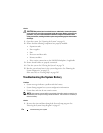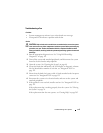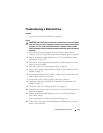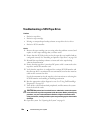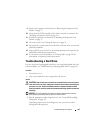
Troubleshooting Your System 175
5
Turn off the system and attached peripherals, and disconnect the system
from the electrical outlet.
6
Open the system. See "Opening the System" on page 68.
7
Ensure that the memory banks are populated correctly. See "General
Memory Module Installation Guidelines" on page 127.
If the memory modules are populated correctly, continue to the next step.
8
Reseat the memory modules in their sockets. See "Installing Memory
Modules" on page 130.
9
Close the system. See "Closing the System" on page 70.
10
Reconnect the system to its electrical outlet, and turn on the system and
attached peripherals.
11
Enter the System Setup program and check the system memory setting.
See "Entering the System Setup Program" on page 43.
If the amount of memory installed still does not match the system
memory setting, proceed to the next step.
12
Turn off the system and attached peripherals, and disconnect the system
from its electrical outlet.
13
Open the system. See "Opening the System" on page 68.
14
If a diagnostic test or error message indicates a specific memory module as
faulty, swap or replace the module. Otherwise, swap the memory module
in the first DIMM socket with a module of the same type and capacity that
is known to be good. See "Installing Memory Modules" on page 130.
15
Close the system. See "Closing the System" on page 70.
16
Reconnect the system to its electrical outlet, and turn on the system and
attached peripherals.
17
As the system boots, observe any error message that appears and the
diagnostic indicators on the front of the system.
18
If the memory problem is still indicated, repeat step 12 through step 17 for
each memory module installed.
If the problem persists, see
"Getting Help
" on page 205.






